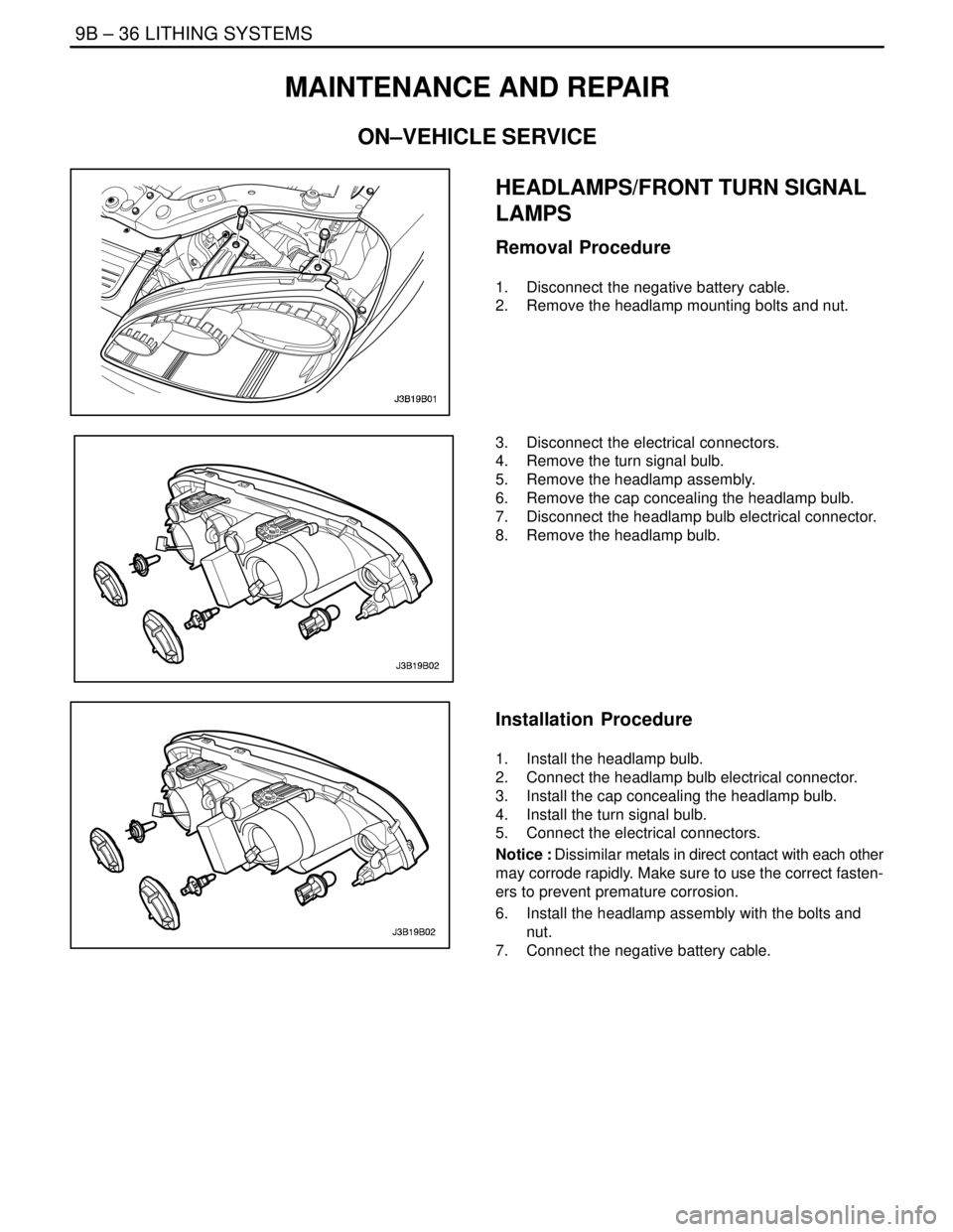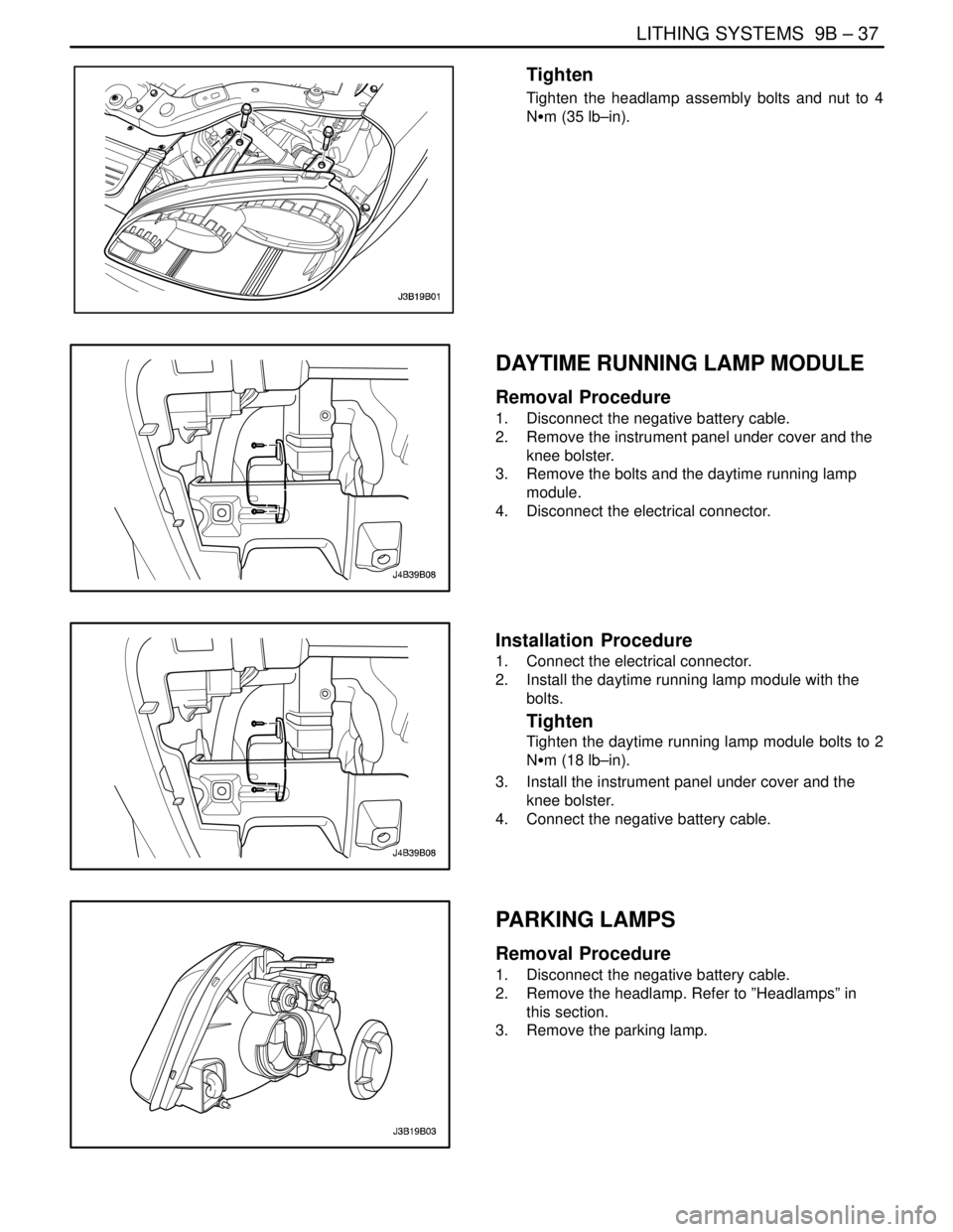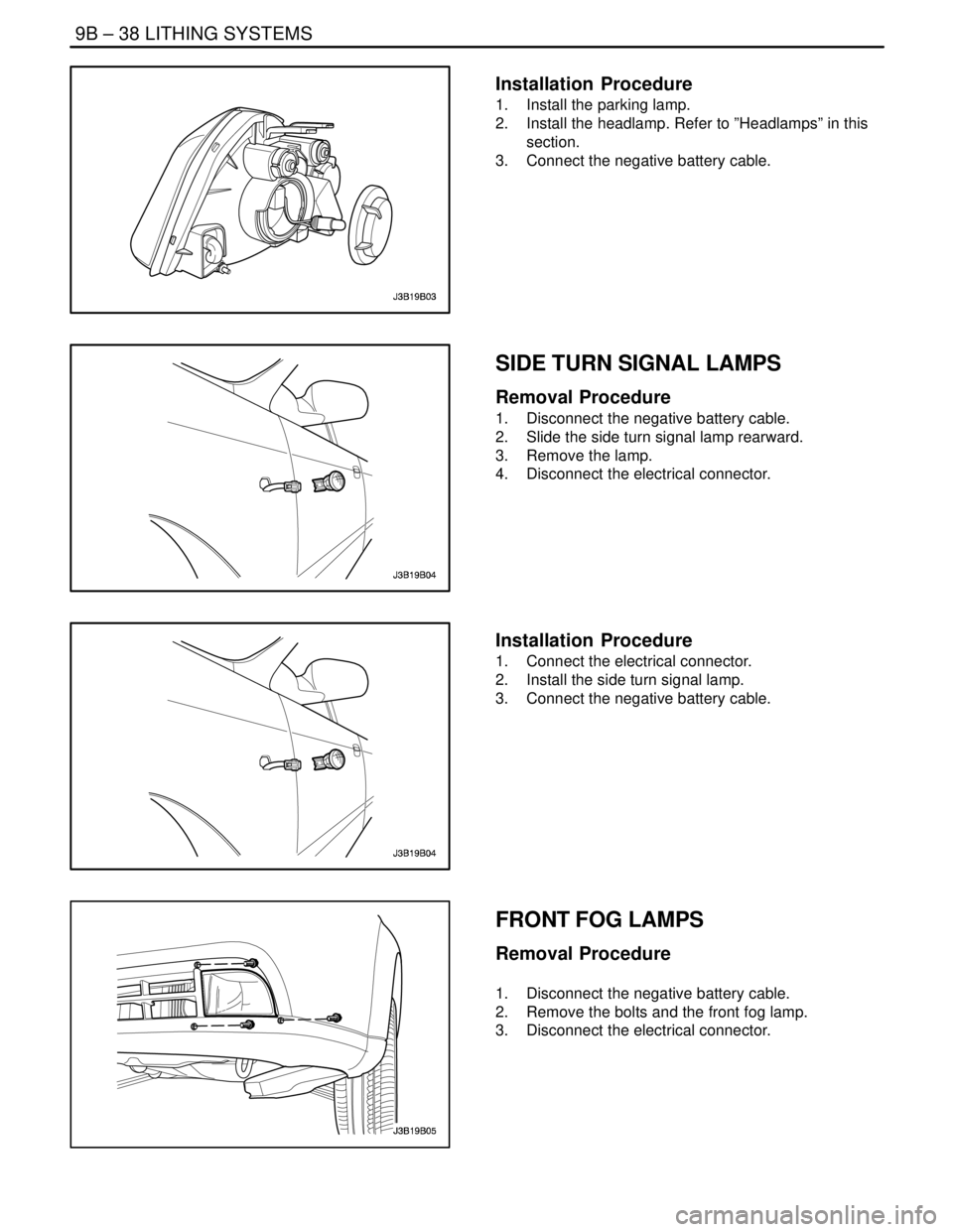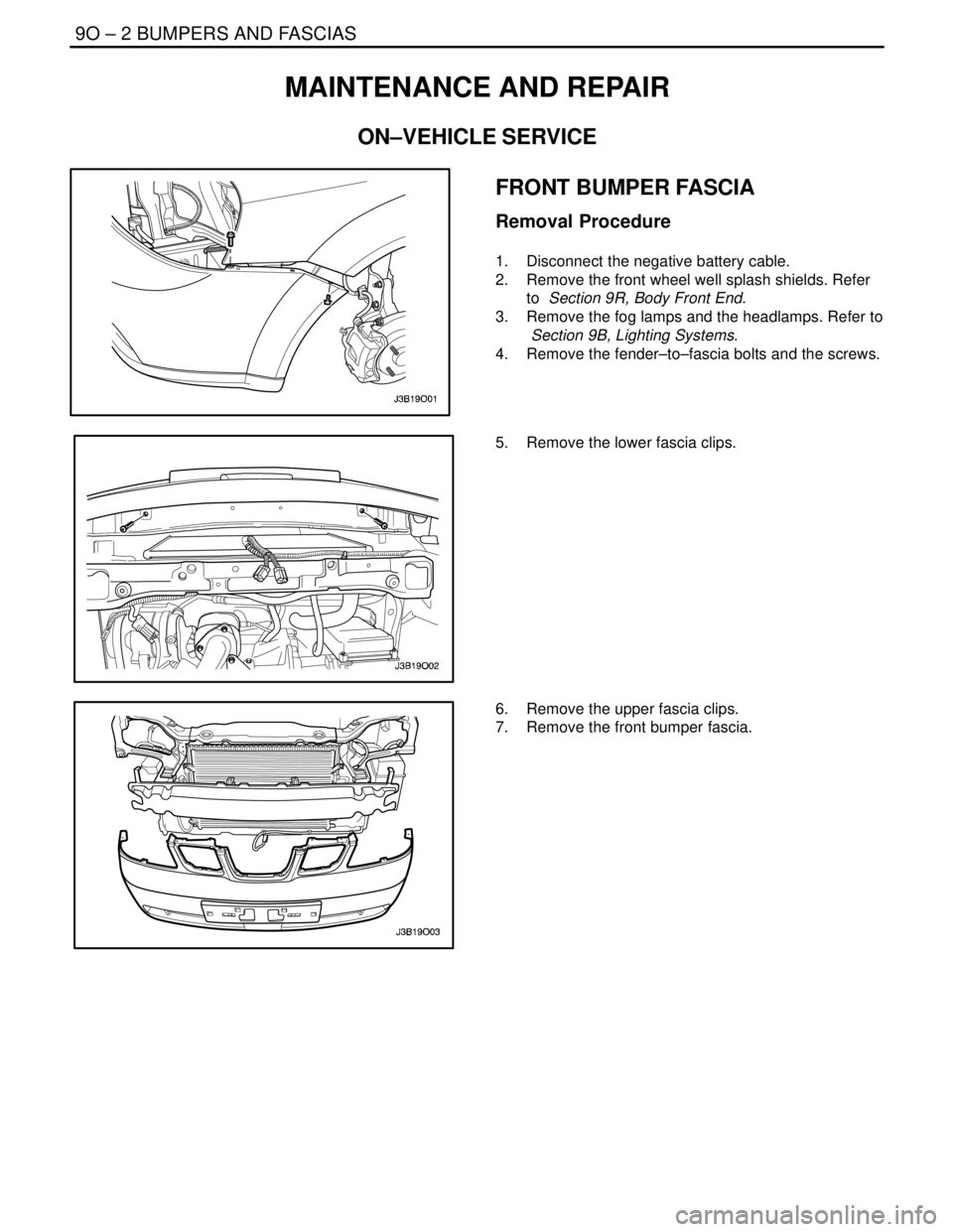2004 DAEWOO NUBIRA headlamp
[x] Cancel search: headlampPage 2260 of 2643

9B – 34ILIGHTING SYSTEMS
DAEWOO V–121 BL4
FOG LAMPS
Diagnostic Aids
The front fog lamps will not operate unless the illumination lamps or daytime running lamps are on. If the illumination lamps
or daytime running lamps are not operating, repair that problem before attempting to diagnose the fog lamps.
Front Fog Lamps Inoperative
StepActionValue(s)YesNo
1Check fuse Ef24.
Is fuse Ef24 blown?–Go to Step 2Go to Step 3
21. Check for a short circuit and repair it, if neces-
sary.
2. Replace the fuse.
Is the repair complete?–System OK–
3Use a voltmeter to check fuse Ef24.
Does the battery voltage available at fuse Ef24 equal
the specified value?11–14 vGo to Step 5Go to Step 4
4Repair the open circuit from the battery to fuse Ef24.
Is the repair complete?–System OK–
5Remove the fog lamp relay and temporarily substi-
tute a known good relay, such as the headlamp relay.
(Do not substitute the illumination lamp relay.)
Do the fog lamps work with the substituted relay?–Go to Step 6Go to Step 7
61. Return the substituted relay to its original posi-
tion.
2. Replace the inoperative fog lamp relay.
Is the repair complete?–System OK–
71. Return the substituted relay to its original posi-
tion, but do not reinstall the fog lamp relay.
2. Turn on the exterior lamps and the front fog
lamps.
3. Using a voltmeter, check the fog lamp relay
socket at the connector for fog lamp relay ter-
minal 30.
Does the voltage available at the fog lamp relay
socket equal the specified value?11–14 vGo to Step 9Go to Step 8
8Repair the open circuit between fuse Ef24 and the
fog lamp relay.
Is the repair complete?–System OK–
9At the fog lamp relay socket, use an ohmmeter to
verify that the connector for relay terminal 85 is con-
nected to ground.
Does the resistance equal the specified value?0 WGo to Step 11Go to Step 10
10Repair the ground circuit for the fog lamp relay.
Is the repair complete?–System OK–
111. Reinstall the fog lamp relay.
2. Turn ON the exterior lamps and the front fog
lamps.
3. Test for voltage at terminal 2 of the fog lamp
connector.
Does the battery voltage available at terminal 2 of
the fog lamp connector equal the specified value?11–14 vGo to Step 13Go to Step 12
Page 2262 of 2643

9B – 36ILITHING SYSTEMS
DAEWOO V–121 BL4
MAINTENANCE AND REPAIR
ON–VEHICLE SERVICE
HEADLAMPS/FRONT TURN SIGNAL
LAMPS
Removal Procedure
1. Disconnect the negative battery cable.
2. Remove the headlamp mounting bolts and nut.
3. Disconnect the electrical connectors.
4. Remove the turn signal bulb.
5. Remove the headlamp assembly.
6. Remove the cap concealing the headlamp bulb.
7. Disconnect the headlamp bulb electrical connector.
8. Remove the headlamp bulb.
Installation Procedure
1. Install the headlamp bulb.
2. Connect the headlamp bulb electrical connector.
3. Install the cap concealing the headlamp bulb.
4. Install the turn signal bulb.
5. Connect the electrical connectors.
Notice : Dissimilar metals in direct contact with each other
may corrode rapidly. Make sure to use the correct fasten-
ers to prevent premature corrosion.
6. Install the headlamp assembly with the bolts and
nut.
7. Connect the negative battery cable.
Page 2263 of 2643

LITHING SYSTEMS 9B – 37
DAEWOO V–121 BL4
Tighten
Tighten the headlamp assembly bolts and nut to 4
NSm (35 lb–in).
DAYTIME RUNNING LAMP MODULE
Removal Procedure
1. Disconnect the negative battery cable.
2. Remove the instrument panel under cover and the
knee bolster.
3. Remove the bolts and the daytime running lamp
module.
4. Disconnect the electrical connector.
Installation Procedure
1. Connect the electrical connector.
2. Install the daytime running lamp module with the
bolts.
Tighten
Tighten the daytime running lamp module bolts to 2
NSm (18 lb–in).
3. Install the instrument panel under cover and the
knee bolster.
4. Connect the negative battery cable.
PARKING LAMPS
Removal Procedure
1. Disconnect the negative battery cable.
2. Remove the headlamp. Refer to ”Headlamps” in
this section.
3. Remove the parking lamp.
Page 2264 of 2643

9B – 38ILITHING SYSTEMS
DAEWOO V–121 BL4
Installation Procedure
1. Install the parking lamp.
2. Install the headlamp. Refer to ”Headlamps” in this
section.
3. Connect the negative battery cable.
SIDE TURN SIGNAL LAMPS
Removal Procedure
1. Disconnect the negative battery cable.
2. Slide the side turn signal lamp rearward.
3. Remove the lamp.
4. Disconnect the electrical connector.
Installation Procedure
1. Connect the electrical connector.
2. Install the side turn signal lamp.
3. Connect the negative battery cable.
FRONT FOG LAMPS
Removal Procedure
1. Disconnect the negative battery cable.
2. Remove the bolts and the front fog lamp.
3. Disconnect the electrical connector.
Page 2272 of 2643

9B – 46ILITHING SYSTEMS
DAEWOO V–121 BL4
GENERAL DESCRIPTION
AND SYSTEM OPERATION
HEADLAMPS–ON REMINDER CHIME
When the headlamp switch is in the headlamps–on or
parking lamps–on position, voltage is applied to the chime
module. When the ignition is in ON, ACC or START, volt-
age is applied through the fuse block to the module. These
two voltages are sensed, and the chime module is not
sounded.
When the ignition is not in ON, ACC or START, the module
loses voltage. The chime module senses change. If the
voltage is still available, it is applied to sound the chime.
The chime can be turned off by turning the headlamp
switch off. The module no longer senses voltage from the
headlamp switch, so the chime module does not sound.
HEADLAMPS
The headlamps are controlled by the multifunction lever
located on the left side of the steering column. They will
come on with the ignition switch in any position. Turning
the headlamp switch to the first position turns on the park-
ing lamps, the license plate lamps and the instrument pan-
el illumination. Turning the switch to the second position
turns on all of the previous lamps and the headlamps.
Turning the switch to the OFF position turns off all the
lamps.
Headlamp high beams and low beams are also controlled
by this lever. When the headlamps are on, pushing the le-
ver away from the driver until the switch clicks changes the
lamp from low beam to high beam. An indicator lamp on
the instrument cluster assembly will come on when the
high beam headlamps are on. To return the headlamps to
low beam, pull the lever toward the driver.
The headlamps must be aimed for proper illumination of
the road. Headlamp aim should be checked whenever a
new headlamp assembly is installed, or whenever service
repairs to the front end area may have disturbed the head-
lamp assembly or its mountings.
DAYTIME RUNNING LAMPS
The Daytime Running Lamps (DRL) will come on when:
S The ignition is ON.
S The light is OFF.
S The parking brake is released.
When the exterior lights are on, the DRL will turn off. To
turn the DRL off when idling, apply the parking brake.
PARKING AND TURN SIGNAL LAMPS
The parking lamps can be turned on by turning the lighting
switch to the first position. The parking lamps can be
turned off by turning the switch to the OFF position.When the turn signals are activated, the front and rear turn
signal lamps flash to signal a turn. The turn signals work
only when the ignition is ON.
The turn signals are controlled by the light switch on the
left side of the steering column. Moving the lever all the
way up or down (past the detent) will turn on the front and
rear turn signals. When the turn is completed, the lever will
return to horizontal and the turn signals will stop flashing.
For changing lanes, or for shallow turns in which the steer-
ing wheel does not turn far enough to cancel the signal,
move the signal lever only to the first detent and hold it
there. When the lever is released, it will return to horizontal
and the turn signals will cancel.
FOG LAMPS
The fog lamp switch is on the instrument panel to the right
of the steering column. To use the fog lamps, first turn on
the headlamps or the parking lamps. Then push the fog
lamp switch. The indicator light in the switch will illuminate
to indicate that the fog lamps are on. Push the switch again
to turn off the fog lamps. The indicator light will then go off.
The fog lamps should not be used as a substitute for the
headlamps.
The fog lamps must be aimed for proper illumination of the
road. Fog lamp aim should be checked when a new bulb
is installed or if service or repairs in the front end area may
have disturbed the fog lamp mountings.
REAR COMBINATION LAMPS
The taillamps, stoplamps, turn signal lamps and backup
lamp are one assembly.
Turning on either the headlamps or the parking lamps will
also turn on the taillamps. When the brake pedal is
pushed, the taillamps will glow brighter to serve as sto-
plamps.
The center high–mounted stoplamp is located in the rear
window and will come on when the brake pedal is pressed.
LICENSE PLATE LAMP
The license plate lamps will come on when the headlamps
or the parking lamps are on. The license plate lamps are
mounted above the license plate.
INTERIOR COURTESY LAMP
The courtesy lamp is located on the headliner just behind
the front seats. The lamp switch has three positions. If the
switch is left in the center position, the lamp will go on
whenever a door is opened and go off when it is closed.
In the ON position, the lamp will stay on until it is turned off.
In the OFF position, the lamp will not come on, even when
a door is opened.
LUGGAGE COMPARTMENT LAMP
The luggage compartment lamp is located under the deck
lid sill plate on the notchback. The lamp is located on the
left–side wheelhouse trim panel on the hatchback. It will
come on whenever the luggage compartment is opened.
Page 2300 of 2643

SECTION : 9E
INSTRUMENTATION/DRIVER INFORMATION
CAUTION : Disconnect the negative battery cable before removing or installing any electrical unit or when a tool
or equipment could easily come in contact with exposed electrical terminals. Disconnecting this cable will help
prevent personal injury and damage to the vehicle. The ignition must also be in LOCK unless otherwise noted.
TABLE OF CONTENTS
SPECIFICATIONS9E–2 . . . . . . . . . . . . . . . . . . . . . . . . . .
Fastener Tightening Specifications 9E–2. . . . . . . . . . .
Instrument Cluster Indicator Lamps
Specifications 9E–2. . . . . . . . . . . . . . . . . . . . . . . . . . .
SCHEMATIC AND ROUTING DIAGRAMS9E–3 . . . . .
Instrument Cluster Circuit (1 of 2) 9E–3. . . . . . . . . . . .
Instrument Cluster Circuit (2 of 2) 9E–4. . . . . . . . . . . .
Cigar Lighter And Extra Power Jack Circuit 9E–5. . . .
DIAGNOSIS9E–6 . . . . . . . . . . . . . . . . . . . . . . . . . . . . . . . .
Cigar Lighter 9E–6. . . . . . . . . . . . . . . . . . . . . . . . . . . . . .
Digital Clock 9E–7. . . . . . . . . . . . . . . . . . . . . . . . . . . . . .
Instrument Panel Illumination 9E–9. . . . . . . . . . . . . . . .
Speedometer 9E–10. . . . . . . . . . . . . . . . . . . . . . . . . . . .
Fuel Gauge 9E–10. . . . . . . . . . . . . . . . . . . . . . . . . . . . . .
Temperature Gauge 9E–11. . . . . . . . . . . . . . . . . . . . . . .
Instrument Cluster Indicator Lamps 9E–12. . . . . . . . .
Chime Module 9E–13. . . . . . . . . . . . . . . . . . . . . . . . . . . .
Chime Module 9E–14. . . . . . . . . . . . . . . . . . . . . . . . . . . .
MAINTENANCE AND REPAIR9E–18 . . . . . . . . . . . . . .
ON–VEHICLE SERVICE 9E–18. . . . . . . . . . . . . . . . . . . .
Center Molding 9E–18. . . . . . . . . . . . . . . . . . . . . . . . . . .
Instrument Cluster Trim Panel 9E–18. . . . . . . . . . . . . .
Garnish Molding 9E–19. . . . . . . . . . . . . . . . . . . . . . . . . .
Ashtray 9E–19. . . . . . . . . . . . . . . . . . . . . . . . . . . . . . . . . . Cigar Lighter 9E–20. . . . . . . . . . . . . . . . . . . . . . . . . . . . .
Glove Box 9E–20. . . . . . . . . . . . . . . . . . . . . . . . . . . . . . .
Notchback Deposit Box 9E–21. . . . . . . . . . . . . . . . . . . .
Notchback Digital Clock 9E–21. . . . . . . . . . . . . . . . . . .
Hatchback Digital Clock 9E–22. . . . . . . . . . . . . . . . . . .
Instrument Cluster 9E–23. . . . . . . . . . . . . . . . . . . . . . . .
Instrument Cluster Dimmer/Headlamp
Leveling Switch 9E–23. . . . . . . . . . . . . . . . . . . . . . . . .
Instrument Cluster Indicator Lamps 9E–24. . . . . . . . .
Instrument Panel 9E–24. . . . . . . . . . . . . . . . . . . . . . . . .
Chime Module 9E–28. . . . . . . . . . . . . . . . . . . . . . . . . . . .
GENERAL DESCRIPTION AND SYSTEM
OPERATION9E–30 . . . . . . . . . . . . . . . . . . . . . . . . . . . . .
Cigar Lighter 9E–30. . . . . . . . . . . . . . . . . . . . . . . . . . . . .
Ashtray 9E–30. . . . . . . . . . . . . . . . . . . . . . . . . . . . . . . . . .
Instrument Panel Vents 9E–30. . . . . . . . . . . . . . . . . . . .
Glove Box 9E–30. . . . . . . . . . . . . . . . . . . . . . . . . . . . . . .
Digital Clock 9E–30. . . . . . . . . . . . . . . . . . . . . . . . . . . . .
Instrument Cluster 9E–30. . . . . . . . . . . . . . . . . . . . . . . .
Speedometer/Odometer/Trip Odometer 9E–30. . . . . .
Fuel Gauge 9E–30. . . . . . . . . . . . . . . . . . . . . . . . . . . . . .
Temperature Gauge 9E–30. . . . . . . . . . . . . . . . . . . . . . .
Instrument Cluster Indicator Lamps 9E–30. . . . . . . . .
Chime Module 9E–30. . . . . . . . . . . . . . . . . . . . . . . . . . . .
Page 2329 of 2643

9E – 30IINSTRUMENTATION/DRIVER INFORMATION
DAEWOO V–121 BL4
GENERAL DESCRIPTION
AND SYSTEM OPERATION
CIGAR LIGHTER
The cigar lighter is located in the front portion of the floor
console. To use the lighter, push it in completely. When the
lighter is hot, it will release itself from contact with the heat-
ing element. The lighter and the heating element can be
damaged if the lighter is not allowed to release itself fully
from the heating element.
ASHTRAY
The ashtray is located below the audio system. To access
the ashtray, pull it out from the center console. The ashtray
lamp will go on when the parking lamps or the headlamps
are turned on.
INSTRUMENT PANEL VENTS
The center and the side vents in the instrument panel can
be adjusted up and down and from side to side. The side
vents can also be aimed toward the side windows in order
to defog them.
GLOVE BOX
The glove box can be opened by pulling up on the latch
handle. The glove box must be removed in order to gain
access to the passenger’s side airbag module.
DIGTAL CLOCK
The digital clock is located in the instrument panel, above
the audio system. The clock is capable of a 12–hour or a
24–hour display.
INSTRUMENT CLUSTER
The instrument cluster is located above the steering col-
umn and in the instrument cluster trim panel. The instru-
ment cluster contains the instruments that provide the
driver with vehicle performance information. The instru-
ment cluster contains a speedometer, an odometer, a trip
odometer, a temperature gauge, a fuel gauge, and several
indicator lamps. For replacement of the indicator lamp
bulbs contained in the instrument cluster, refer to ”Instru-
ment Cluster Indicator Lamps Specifications” and”Instru-
ment Cluster Indicator Lamps” in this section.
SPEEDOMETER/ODOMETER/TRIP
ODOMETER
The speedometer measures the speed of the vehicle in
km/h (mph in some countries). It consists of an instrument
cluster gauge connected to the vehicle speed sensor
(VSS) on the transaxle output shaft.The odometer measures in kilometers (miles in some
countries) the total distance the vehicle has traveled since
it was manufactured. It consists of an instrument cluster
gauge connected to the VSS on the transaxle output shaft.
The trip odometer measures the distance the vehicle has
traveled since the odometer was last reset. It consists of
an instrument cluster gauge connected to the VSS on the
transaxle output shaft. The trip odometer can be reset to
zero at any time so that the driver can record the distance
traveled from any starting point.
FUEL GAUGE
The fuel gauge consists of an instrument cluster gauge
connected to a sending unit in the fuel tank.
The fuel gauge indicates the quantity of fuel in the tank
only when the ignition switch is turned to ON or ACC.
When the ignition is turned to LOCK or START, the pointer
may come to rest at any position.
TEMPERATURE GAUGE
The temperature gauge consists of an instrument cluster
gauge connected to a temperature sensor that is in con-
tact with the circulating engine coolant.
The temperature gauge indicates the temperature of the
coolant. Prolonged driving or idling in very hot weather
may cause the pointer to move beyond the center of the
gauge. The engine is overheating if the pointer moves into
the red zone at the upper limit of the gauge.
INSTRUMENT CLUSTER INDICATOR
LAMPS
The instrument cluster contains indicator lamps that indi-
cate the functioning of certain systems or the existence of
potential problems with the operation of the vehicle. The
indicator lamps are replaceable. For replacement of the in-
dicator lamps contained in the instrument cluster, refer to
”Instrument Cluster Indicator Lamps Specifications”
and”Instrument Cluster Indicator Lamps” in this section.
CHIME MODULE
The chime module is located above the instrument panel
fuse block and will sound in order to bring attention to one
or more of the following conditions:
S The lamps are on, the door is ajar, and the ignition
switch is not in ACC, ON, or START.
S The seat belt is unbuckled when the ignition switch
is in ON or START.
S The door is open when the ignition switch is in ON
or START.
S The key is left in the ignition switch when the igni-
tion is in LOCK and the door is open.
Page 2413 of 2643

9O – 2IBUMPERS AND FASCIAS
DAEWOO V–121 BL4
MAINTENANCE AND REPAIR
ON–VEHICLE SERVICE
FRONT BUMPER FASCIA
Removal Procedure
1. Disconnect the negative battery cable.
2. Remove the front wheel well splash shields. Refer
to Section 9R, Body Front End.
3. Remove the fog lamps and the headlamps. Refer to
Section 9B, Lighting Systems.
4. Remove the fender–to–fascia bolts and the screws.
5. Remove the lower fascia clips.
6. Remove the upper fascia clips.
7. Remove the front bumper fascia.